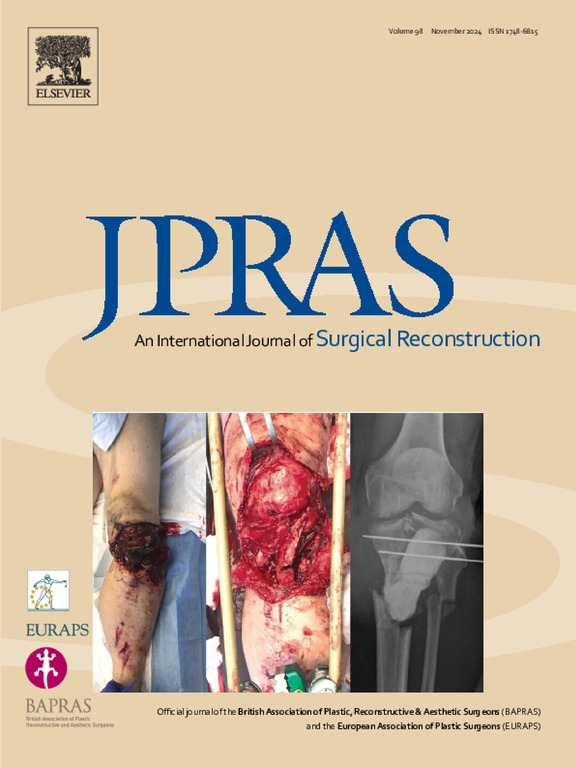Pilomatrixoma: A comprehensive 32-year analysis of clinical and histopathological findings of 1235 patients treated at Mayo Clinic
IF 2
3区 医学
Q2 SURGERY
Journal of Plastic Reconstructive and Aesthetic Surgery
Pub Date : 2025-02-25
DOI:10.1016/j.bjps.2025.02.044
引用次数: 0
Abstract
Research on pilomatrixoma has been limited, with most publications being case series or secondary reviews. This study aimed to analyze data from 1235 cases of pilomatrixoma to provide comprehensive information on demographic distribution, clinical presentations, and histopathological features of pilomatrixoma. A retrospective review was conducted between 1992 and 2024. The pathology database revealed 1235 confirmed cases. There was no significant sex predilection. The age distribution showed a bimodal pattern, with a childhood peak and a second, lower peak between ages 50 and 75 years (mean, 41.3±25.6 years; range, 6 months-92 years). The most common location was the head (45.1%). Multiple occurrences were rare (4%), and we found an association between increased age and decreased risk of multiple manifestations (OR=0.97, P<0.001). Forty patients (3.2%) were reported to have genetic syndromes. Pilomatrixoma was considered in the preoperative diagnosis in 490 cases (37.2%). Additionally, pilomatrixoma with atypical or proliferating features was detected in 24 cases (1.8%). Logistic regression revealed that age is a predictor for the likelihood of developing proliferating or atypical pilomatrixoma (OR=1.04, P<0.001). Among the 137 cases with preoperative imaging, ultrasonography was used the most, but the sensitivity was 29.2%. The recurrence rate was 2.4% among our sample. Recurrence showed no association with age, location, procedure type, pilomatrixoma size, or pathological findings. In conclusion, pilomatrixomas are infrequently suspected preoperatively. Considering the patient's age, the size and location of the lesion may help distinguish it from other benign masses. Recurrence or malignant transformations are extremely rare after complete removal.
毛基质瘤:对在梅奥诊所治疗的1235例患者的32年临床和组织病理学结果的综合分析
关于骨髓瘤的研究有限,大多数出版物是病例系列或二次评论。本研究旨在分析1235例毛原基质瘤的资料,以提供有关毛原基质瘤的人口学分布、临床表现和组织病理学特征的全面信息。在1992年至2024年期间进行了回顾性审查。病理数据库显示1235例确诊病例。没有明显的性别偏好。年龄分布呈双峰型,儿童期为高峰,50 ~ 75岁为低峰(平均41.3±25.6岁;范围:6个月-92年)。最常见的部位是头部(45.1%)。多次出现的情况很少见(4%),我们发现年龄的增加与多种表现的风险降低之间存在关联(OR=0.97, P<0.001)。40例患者(3.2%)报告有遗传综合征。490例(37.2%)患者术前诊断为毛瘤基质瘤。此外,有24例(1.8%)的毛瘤基质瘤具有非典型或增生性特征。Logistic回归显示,年龄是发生增殖性或非典型毛基质瘤可能性的预测因子(or =1.04, P<0.001)。在137例术前影像学检查中,超声检查应用最多,但敏感性为29.2%。本组复发率为2.4%。复发与年龄、部位、手术类型、毛基质瘤大小或病理表现无关。总之,术前很少怀疑毛基质瘤。考虑到患者的年龄,病变的大小和位置可能有助于将其与其他良性肿块区分开来。完全切除后复发或恶性转化极为罕见。
本文章由计算机程序翻译,如有差异,请以英文原文为准。
求助全文
约1分钟内获得全文
求助全文
来源期刊
CiteScore
3.10
自引率
11.10%
发文量
578
审稿时长
3.5 months
期刊介绍:
JPRAS An International Journal of Surgical Reconstruction is one of the world''s leading international journals, covering all the reconstructive and aesthetic aspects of plastic surgery.
The journal presents the latest surgical procedures with audit and outcome studies of new and established techniques in plastic surgery including: cleft lip and palate and other heads and neck surgery, hand surgery, lower limb trauma, burns, skin cancer, breast surgery and aesthetic surgery.

 求助内容:
求助内容: 应助结果提醒方式:
应助结果提醒方式:


